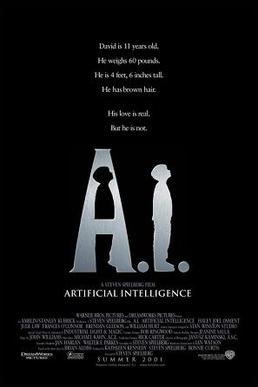Week 3 - Robotics and Art
The terms “industrialization” and “art” often tend to conflict with each other. For a concept to be industrialized is to find the schematic application to the concept and to make the concept available for mass production. On the other hand, for a concept to be more artistic is to refine the concept itself and to emphasize as well as to enhance its unique aesthetic and social values. The industrial products are often lack of aesthetic and emotional values, while the more artistically accoladed works are often harder to massively produce because of their originality.
 However, industrialization does not necessarily contradict with artistry, and does not always annihilate originality. Steven Spielberg’s film, Artificial Intelligence (2001), can be served as an example to illustrate such complex relationships. The main character David, as a highly intelligent robot with emotions, is one of the mass-produced kid robots produced to substitute a human child in a family. With his emotions pre-set to those of a normal human child and to always love his owner (that is, his human mother), David made several mistakes due to his innocence and was exiled from the family. David’s exile can be compared to the potential danger industrialization imposes to the human society, such as unempolyment and industrial accidents.
However, industrialization does not necessarily contradict with artistry, and does not always annihilate originality. Steven Spielberg’s film, Artificial Intelligence (2001), can be served as an example to illustrate such complex relationships. The main character David, as a highly intelligent robot with emotions, is one of the mass-produced kid robots produced to substitute a human child in a family. With his emotions pre-set to those of a normal human child and to always love his owner (that is, his human mother), David made several mistakes due to his innocence and was exiled from the family. David’s exile can be compared to the potential danger industrialization imposes to the human society, such as unempolyment and industrial accidents.
The figure of David as an artificial intelligence rather than a human being is then alleviated throughout his adventure to try to become a real human child. By the time David reached the factory where he was produced and saw a great many other robots with appearances exactly like him, he was despaired because he find himself not UNIQUE. 

However, such lack of originality was then reversed by David’s action of jumping into the ocean to try to commit suicide, an action that definitely makes him humane. At the end of the movie, when the robots 2,000 years later asked David what he wants, David chooses to spend a day with the clone of his human mom like a real human child. Not only does the movie illustrate the intertwined relationships between robotics and art, the emotions presented throughout the entire film is both strong and highly artistic.

Sources
Benjamin, Walter. The Work of Art in the Age of Mechanical Reproduction. London: Penguin, 2008. Print.
Vesna, Victoria. “Robotics + Art.” Lecture 3.
Artificial Intelligence: A.I. Dir. Steven Spielberg Perf.Haley Joel Osment. Dreamworks, 2001.
“A.I. Artificial Intelligence (2001)” Internet Movie Database, IMDb, n.d. Web. 23 Apr. 2017. <http://www.imdb.com/title/tt0212720/>
Vesna, Victoria. “Robotics + Art.” Lecture 3.
“A.I. Artificial Intelligence” Wikipedia, The Free Encyclopedia. Wikipedia, The Free Encyclopedia, n.d. Web. 23 Apr 2017.
I think your movie example, Artificial Intelligence, is very applicable! And as you mentioned, it was hard for people to talk about industrialization and art in the same conversation, but now, people combine science and art much more frequently. Virtual reality is one of the hottest topics now, and it uses the combination of the two cultures. The visual effects and display are all derived from artistic abilities. The technology and programming come from a science background. Only with the combination of the two cultures can virtual reality become so popular with the special effects and firsthand virtual experience.
ReplyDelete